Claude Monet, a visionary artist of the 19th century, emerged as a trailblazer of the artistic revolution, pushing the boundaries with his extraordinary style and a remarkable talent for capturing the fleeting interplay of light and color. He is one of my favorite Impressionism artists.
Claude Monet, one of the leading figures of the Impressionist movement, Monet’s works encapsulated fleeting moments, evoking profound emotions and immortalizing the ethereal beauty of the natural world. With his revolutionary approach, Monet shattered the conventions of traditional art, giving birth to a new artistic language that celebrated the transient and embraced the ever-changing nature of existence.
Table of Contents
- Masterpieces Of Light: Exploring Claude Monet’s 13 Most Famous Paintings
- Claude Monet: A Visionary Of Impressionism
- Sunrise (Marine) – 1872 By Claude Monet
- Impression, Sunrise – 1872 By Claude Monet
- Woman With A Parasol – Madame Monet And Her Son – 1875 By Claude Monet
- Rouen Cathedral Series – 1892-1894 By Claude Monet
- Water Lilies And Japanese Bridge – 1899 By Claude Monet
- Haystacks Series – 1890-1891 By Claude Monet
- The Gare Saint-Lazare – 1877 By Claude Monet
- The Houses Of Parliament Series – 1899 – 1901 By Claude Monet
- The Artist’s Garden At Giverny – 1900 By Claude Monet
- Poppy Field Near Argenteuil – 1873 By Claude Monet
- The Cliff Walk At Pourville – 1882 By Claude Monet
- The Railway Bridge At Argenteuil – 1874 By Claude Monet
- Waterloo Bridge Series – 1900-1904 By Claude Monet
- Frequently Asked Questions
- Related Questions
Masterpieces Of Light: Exploring Claude Monet’s 13 Most Famous Paintings
Claude Monet, an eminent artist of the 19th century, emerged as a harbinger of artistic revolution with his unparalleled style and the ability to capture the ephemeral interplay of light and color. As a pioneering figure of the Impressionist movement, Monet’s works encapsulated short moments, stirring emotions and immortalizing the ethereal beauty of nature.
Claude Monet: A Visionary Of Impressionism
Claude Monet, born in 1840 and died n 1926, hailed from Le Havre, France, and harbored an unwavering passion for painting from an early age. His relentless pursuit of art as a career led him to become a luminary of the Impressionist movement, redefining the artistic landscape of his time.
Monet’s revolutionary approach focused on capturing the fleeting essence of subjects and instilling them with vitality.
Read on as we embark on a journey into the life of Claude Monet, his profound contribution to the realm of Impressionism, with an intimate exploration of 13 of his most iconic paintings, each marking a significant milestone in the annals of art history.
Sunrise (Marine) – 1872 By Claude Monet
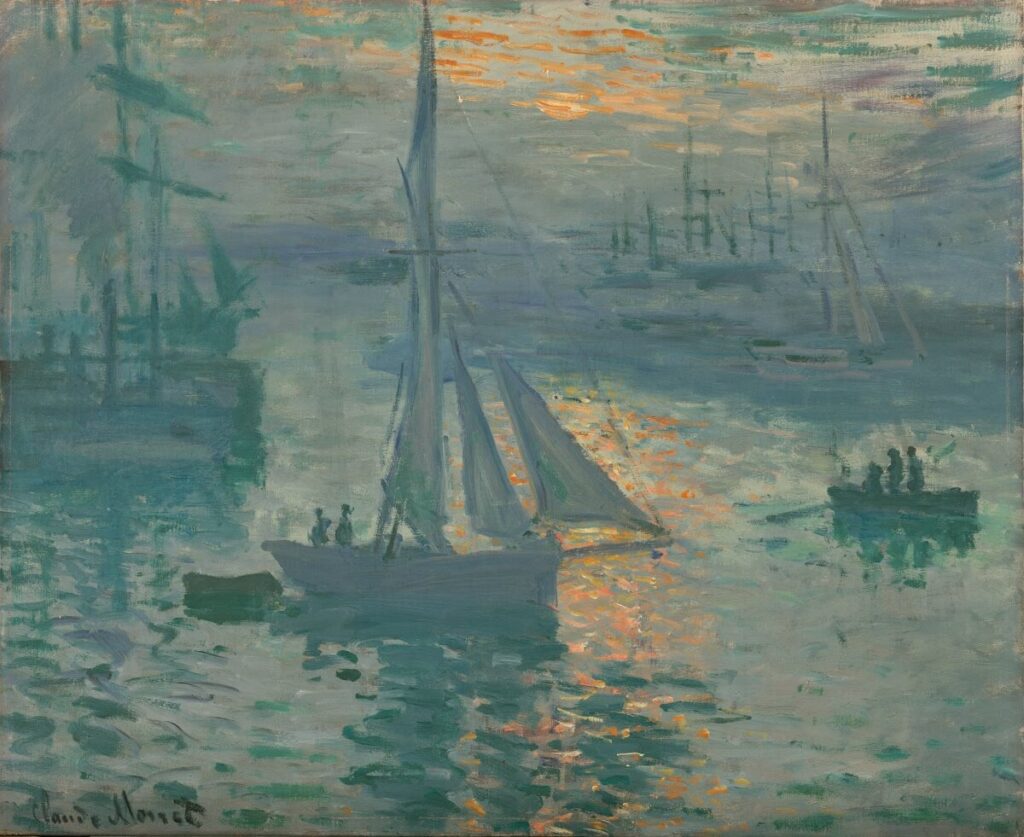
Among Monet’s oeuvre, “Sunrise (Marine)” holds a pivotal position as the very catalyst that bestowed the name “Impressionism” upon the artistic movement. With masterful brushwork and a breathtaking palette,
Monet vividly depicts the rising sun, employing color and light to evoke an ethereal quality, as if the entire canvas were painted in a delicate haze. This painting should not be confused with the Impression Sunrise painting.
Impression, Sunrise – 1872 By Claude Monet

Another fantastic piece epitomizing Monet’s signature style is “Impression, Sunrise.” This painting is an iconic representation of Impressionism, capturing the essence of fleeting impressions with loose brushstrokes and vibrant colors.
Through a deft interplay of light, shadow, and reflection, Monet immerses the viewer in a scene of harbor tranquility, igniting an emotional response to the beauty of the natural world.
It was from this painting that the Impressionism movement received its name.
Woman With A Parasol – Madame Monet And Her Son – 1875 By Claude Monet
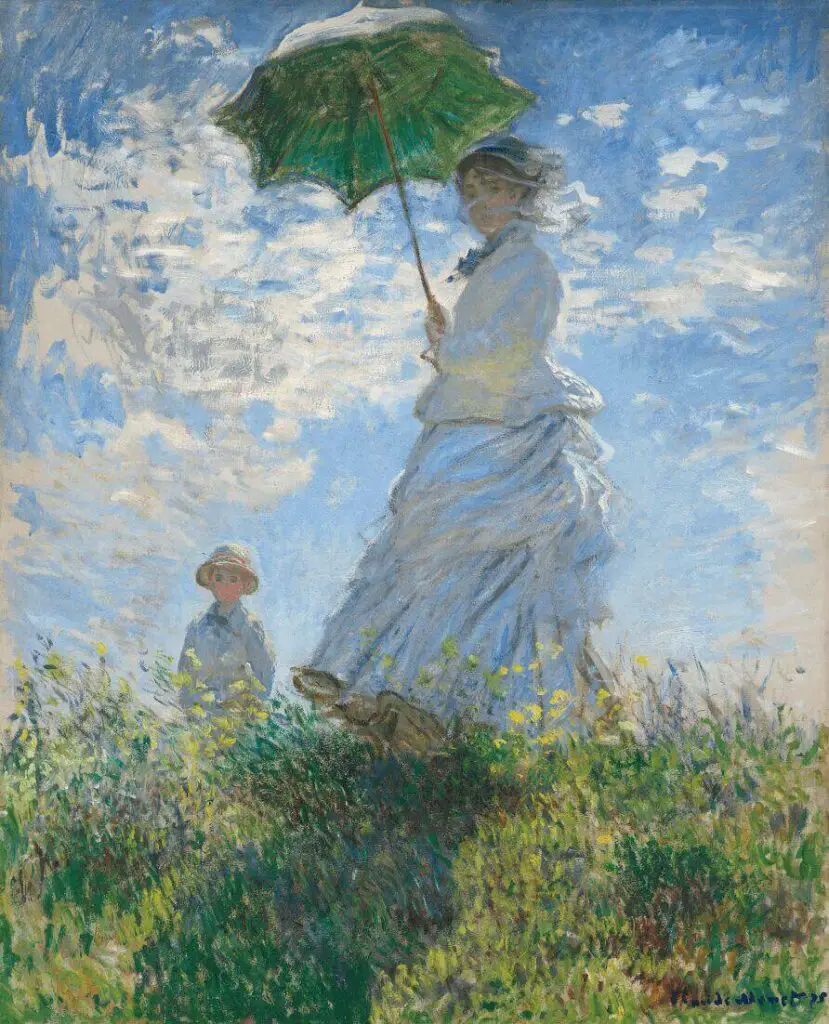
“Woman with a Parasol – Madame Monet and Her Son” is a captivating portrait of Monet’s wife and son in an outdoor setting. This masterpiece beautifully conveys a sense of spontaneity and intimate connection between the subjects and their surroundings.
Monet’s skilled handling of light, manifested through the dappled shadows and gentle breezes, infuses the painting with a sense of movement and vivacity.
Rouen Cathedral Series – 1892-1894 By Claude Monet
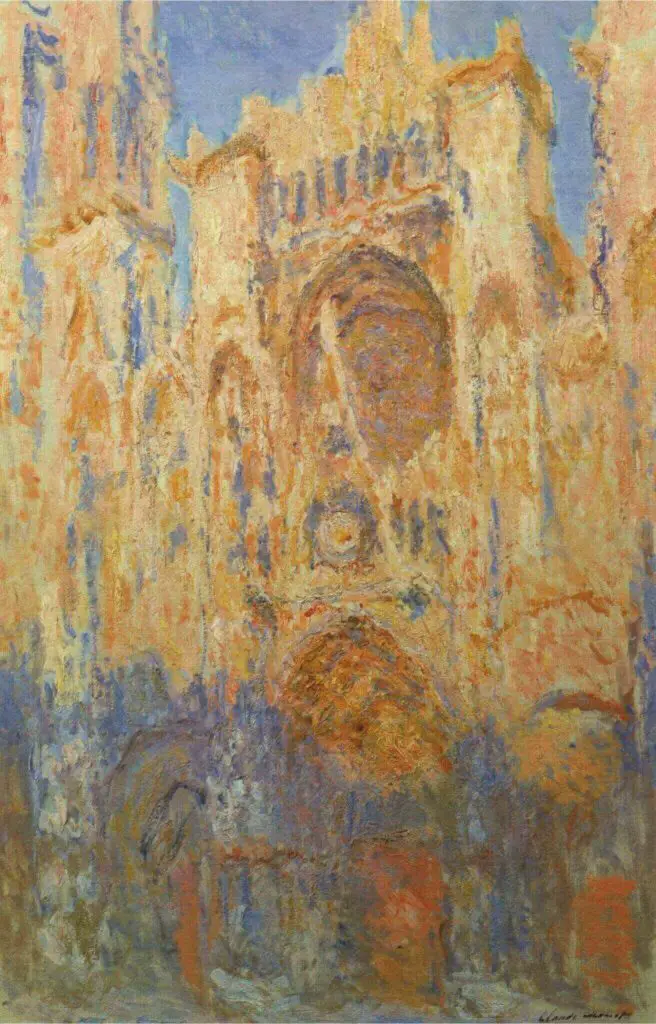
The Rouen Cathedral series comprises a collection of masterpieces wherein Monet captured the ever-changing light and atmosphere on the facade of the Rouen Cathedral. These paintings are a testament to Monet’s unwavering dedication to capturing the ephemeral, as he painted the same subject under varying lighting conditions.
The result is a breathtaking display of skillful manipulation of color and a profound understanding of the interplay between light and architectural forms.
Water Lilies And Japanese Bridge – 1899 By Claude Monet
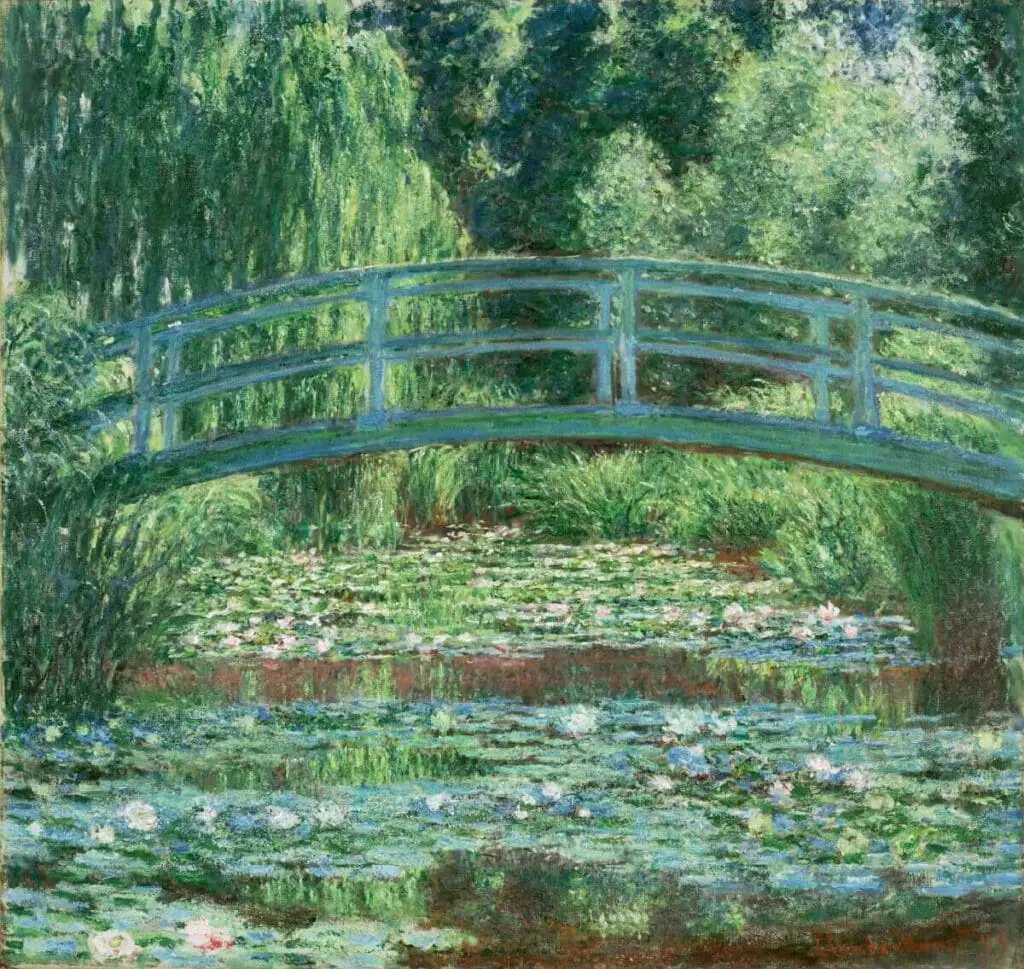
Among Monet’s most celebrated works, “Water Lilies and Japanese Bridge” transports viewers into the artist’s private haven—the water garden at Giverny. Monet’s innovative composition and masterful handling of color and texture evoke a sense of serenity and immersion in nature.
The reflection of the water lilies on the tranquil pond and the arched bridge create an otherworldly atmosphere that invites contemplation and introspection.
Haystacks Series – 1890-1891 By Claude Monet
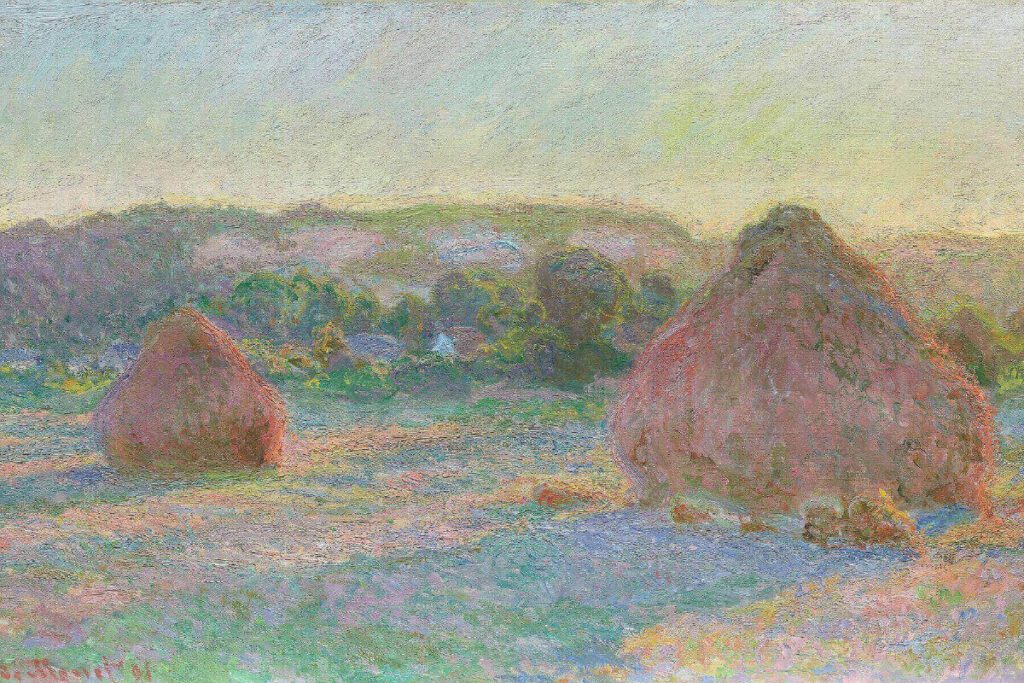
Monet’s Haystacks series is a testament to his deep exploration of light and its effects on ordinary subjects. Throughout multiple paintings, Monet captured the transient atmospheric conditions surrounding haystacks at different times of the day. By repetitively depicting this seemingly mundane subject,
Monet showcased his ability to portray the ever-changing play of light, imbuing each painting with a distinct mood and ambiance.
The Gare Saint-Lazare – 1877 By Claude Monet

In “The Gare Saint-Lazare,” Monet showcased his fascination with industrialization and the bustling energy of a train station. The painting captures trains’ smoke, steam, and dynamic movement, highlighting Monet’s versatility as an artist.
He brought life to the scene with bold brushstrokes and a vibrant palette, emphasizing the interplay of light and shadow amidst the urban setting.
The Houses Of Parliament Series – 1899 – 1901 By Claude Monet
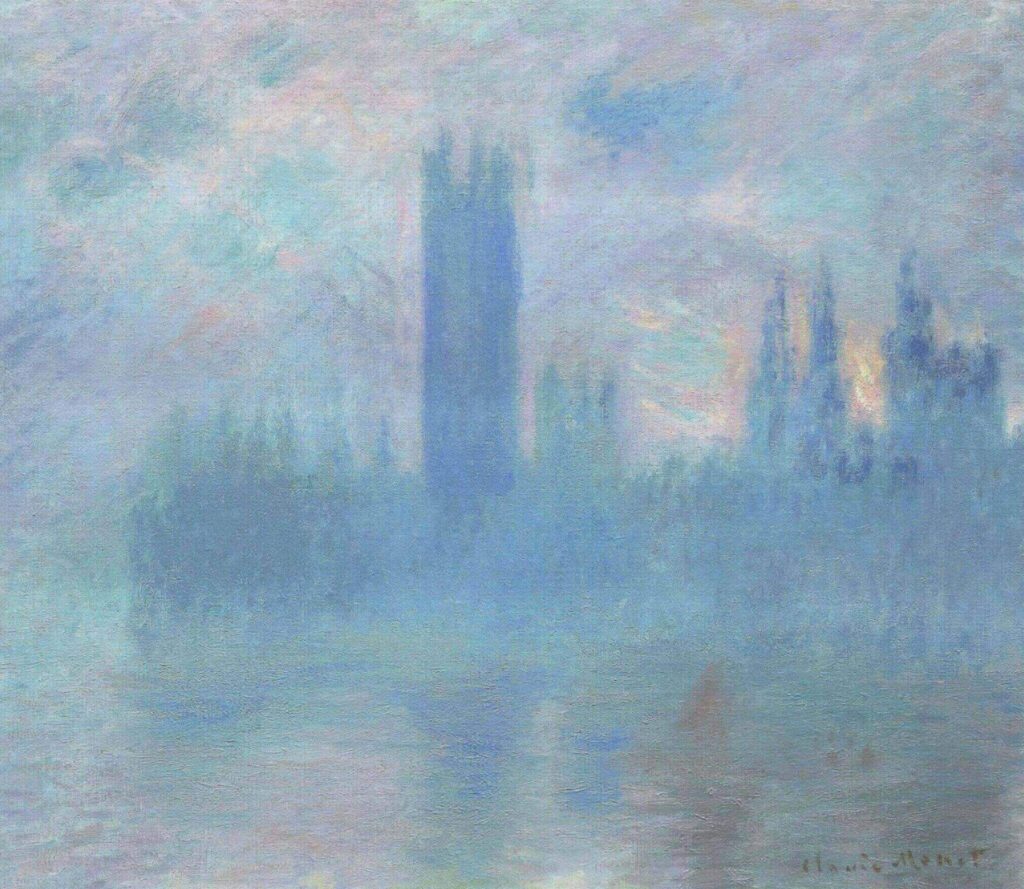
Monet’s fascination with London’s iconic Houses of Parliament and the River Thames is exemplified in his series of paintings dedicated to these subjects. Over several years, Monet meticulously studied the effects of fog on architectural marvels, capturing the atmospheric conditions uniquely and breathtakingly.
The series showcases Monet’s ability to evoke mood and create an ethereal, dreamlike quality in his works.
The Artist’s Garden At Giverny – 1900 By Claude Monet

“The Artist’s Garden at Giverny” captures Monet’s sanctuary. The painting presents a meticulously cultivated garden with vibrant flowers and lush greenery. Monet’s keen eye for detail and skillful use of color and light bring the garden to life, immersing viewers in a tranquil and idyllic setting.
The painting embodies Monet’s love for nature and ability to infuse his artworks with a sense of serenity.
Poppy Field Near Argenteuil – 1873 By Claude Monet
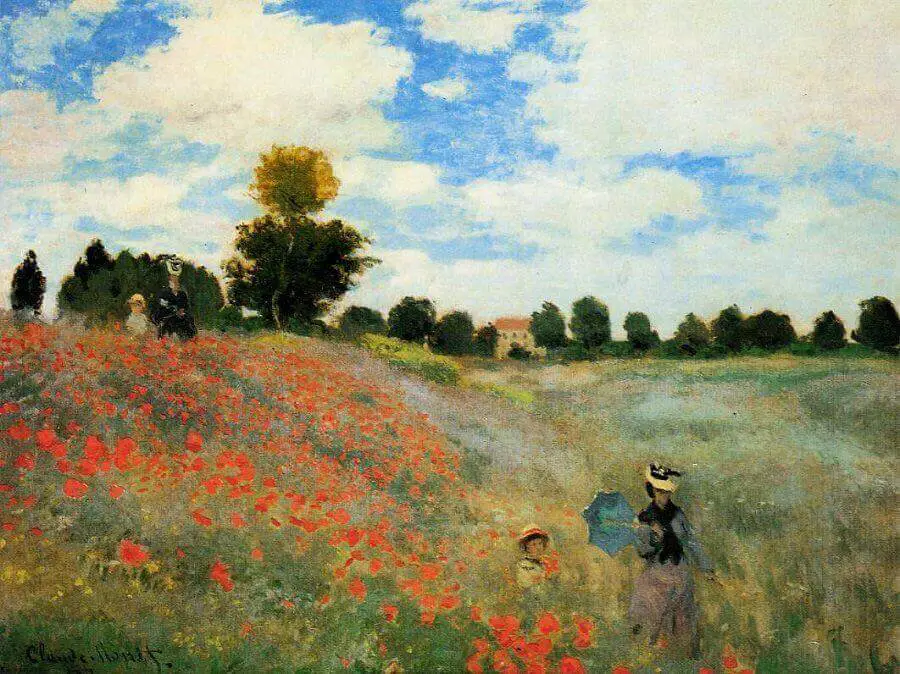
“Poppy Field near Argenteuil” is a mesmerizing depiction of a sea of vibrant red poppies against a backdrop of lush greenery. With loose brushwork and a brilliant color palette, Monet conveys the fleeting beauty of the natural world.
The painting exudes energy and captures the essence of a sunny summer day, inviting viewers to immerse themselves in the enchanting landscape.
The Cliff Walk At Pourville – 1882 By Claude Monet
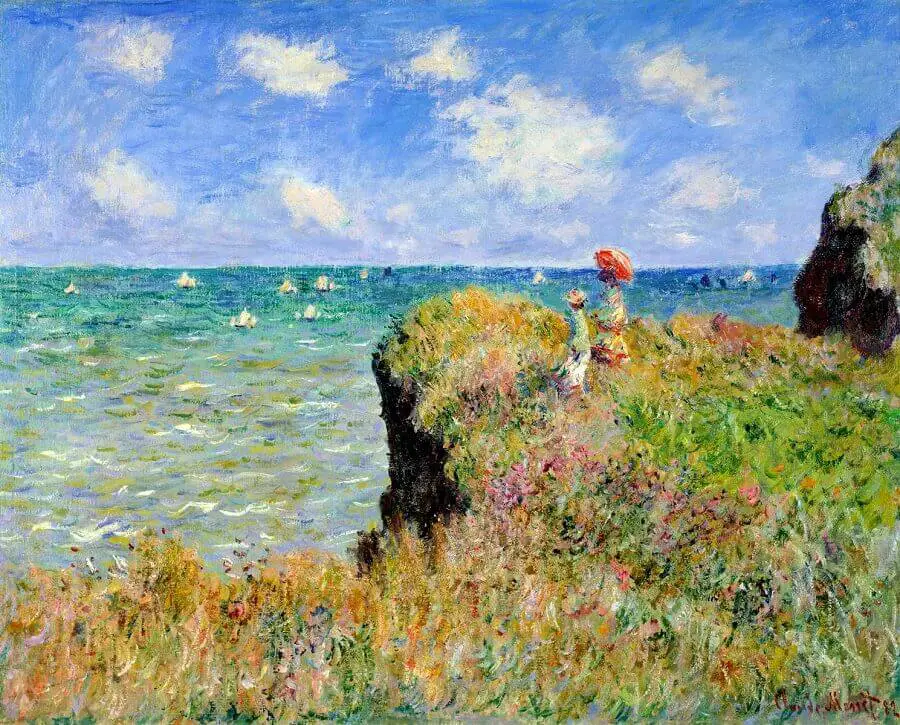
In this painting, Monet portrays the majestic cliffs and turbulent sea at Pourville, a coastal town in Normandy. The Cliff Walk at Pourville showcases Monet’s skill in capturing the ever-shifting moods of the sea and the dramatic effect of light on the rugged cliffs.
The contrast between the water’s vibrant blue hues and the cliffs’ warm tones creates a visually striking composition.
The Railway Bridge At Argenteuil – 1874 By Claude Monet
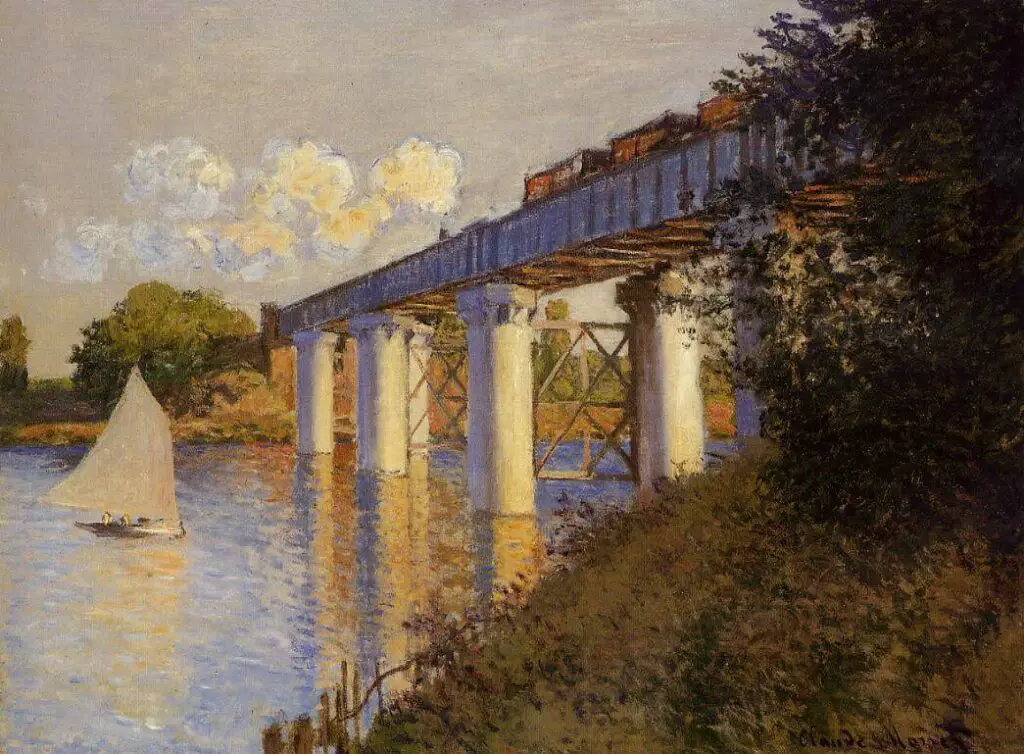
Monet’s “The Railway Bridge at Argenteuil” captures the picturesque scene of a bridge spanning over the tranquil waters of the River Seine. With his characteristic brushstrokes and delicate use of color, Monet renders the reflections of the bridge and its surroundings, blurring the lines between reality and impression.
The painting exemplifies his mastery of capturing the nuances of light and atmosphere.
Waterloo Bridge Series – 1900-1904 By Claude Monet

Monet’s Waterloo Bridge series showcases his fascination with capturing the changing atmospheric conditions and the interplay of light on the iconic London landmark. Through a remarkable range of color and brushwork, Monet immortalizes the bridge in various weather conditions, from misty mornings to vibrant sunsets.
The series demonstrates Monet’s dedication to capturing the nuances of light and his ability to transform a familiar subject into a visual symphony of colors.
Claude Monet’s artistic genius and profound impact on the Impressionist movement cannot be overstated. Through his relentless pursuit of capturing the transient qualities of light, Monet crafted a body of work that continues to inspire and captivate audiences to this day.
Monet’s paintings have left an indelible mark on the art world, from his early groundbreaking pieces that gave birth to the term “Impressionism” to Monet’sonic series depicting natural and artificial landscapes.
Each of the 13 paintings we explore showcases Monet’s mastery of capturing the fleeting beauty of nature, his unparalleled use of color and light, and his ability to evoke emotion through his art. These masterpieces are a testament to Monet’s enduring legacy as one of the greatest artists of all time, forever etching his name in the annals of art history.
Anita Louise Art is dedicated to art education, great artists, and inspiring others to find and create their art. We love art that uplifts and inspires. #ArtToMakeYouSmile! #ArtToMakeYouHappy!
If you are interested to see any of my art, you can find out more by clicking here. If you are interested in what inspires me and my paintings, you can discover more by clicking here.
We have a free newsletter and would love you to be part of our community; you can subscribe to the newsletter by clicking here. I would be happy to talk to you if you have any questions. You can reach me, Anita, by clicking here.
Subscribe to our Anita Louise Art YouTube Channel filled with great videos and information by clicking here.
Join us for our podcast “5 Minutes With Art.” Spend 5 minutes a week with us to discover and learn about great art and artists. You can find out more about our podcast by clicking here.
Frequently Asked Questions
What defines Claude Monet’s artistic style?
Claude Monet was a prominent figure in the Impressionist movement, known for his innovative approach to capturing light and color in a way that conveyed the essence of a moment rather than focusing on precise details.
Which painting is considered Claude Monet’s masterpiece?
While opinions may vary, “Water Lilies” series, particularly the large-scale “Water Lilies and Japanese Bridge,” is often considered one of Monet’s masterpieces, showcasing his mastery of color and reflection.
How did Monet’s paintings revolutionize traditional art?
Monet’s work challenged the established norms of the art world by prioritizing the immediate, transient aspects of nature over detailed realism. His emphasis on capturing the changing effects of light and atmosphere was a departure from traditional techniques.
What is the significance of Monet’s “Impression, Sunrise”?
“Impression, Sunrise” is a pivotal painting that gave the Impressionist movement its name. It symbolizes Monet’s commitment to portraying the fleeting nature of light and atmosphere, setting the tone for the entire movement.
Why did Monet focus extensively on nature, especially water lilies and gardens?
Monet found inspiration in the beauty of nature and sought to convey the ever-changing scenes in gardens and ponds. His fascination with water lilies allowed him to explore the interplay of light and reflection in a tranquil and timeless setting.
How did Monet’s paintings capture the essence of different seasons?
Monet’s series, such as “Haystacks” and “Rouen Cathedral,” showcased his ability to capture the changing seasons by portraying the same subject under different light conditions, emphasizing the atmospheric nuances of each season.
What role did color play in Monet’s paintings?
Color was a central element in Monet’s art. He used vibrant and unconventional color palettes to evoke emotions and capture the nuances of natural light. His use of complementary colors created a sense of harmony and vibrancy in his works.
How did Monet’s failing eyesight influence his later works?
Monet’s declining eyesight in his later years influenced a shift in his style. His brushstrokes became broader and more expressive, leading to a more abstract interpretation of his subjects, as seen in his famous Water Lilies series.
Which painting best exemplifies Monet’s fascination with the play of light on architecture?
“Rouen Cathedral Series” is a prime example of Monet’s fascination with the effects of light on architecture. The series depicts the cathedral at different times of the day, showcasing the changing colors and moods.
How can one best appreciate Monet’s paintings in person?
To fully appreciate Monet’s work, visit museums or galleries housing his paintings. Take the time to observe the brushstrokes, notice the play of light and color, and immerse yourself in the experience to capture the essence of Monet’s revolutionary approach to art.
Related Questions
Claude Monet And His Art Work
Claude Monet was one of the more prolific and consistent Impressionism painters. He believed in painting what was seen in nature and the changing light. He was an en Plein air painter. He is known for his strong and bold colors and short brush strokes.
You can discover more by reading Claude Monet And His Art Work by clicking here.
Similarities Between Claude Debussy And Claude Monet
Claude Debussy is a musical composer. Claude Monet is an artist. They are both considered Impressionists and were not afraid to break from the tradition of their day to create something new. Both Debussy and Monet greatly influenced many artists that went after them.
By clicking here, you can learn more by reading Similarities Of Claude Debussy And Claude Monet.
Why Is Van Gogh Considered Such A Great Artist?
Many things make Vincent Van Gogh unique and great as an artist. He had a great way of using color in his heart, but more than that, he was an artist who set and paved the way, and his brushstroke technique used color and his design ability. What is interesting is that he did this as a self-taught artist.
By clicking here, you can discover more by reading Why Is Van Gogh Considered Such a Great Artist?

